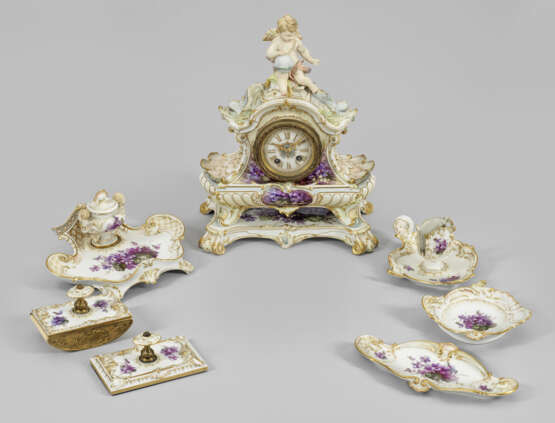ID 801369
Lot 909 | Neorokoko-Kaminuhr und mehrteilige Damenschreibgarnitur
Estimate value
€ 13 000 – 26 000
mit Weichmalerei
8-tlg.; Kaminuhr mit Sockel, Tintengefäß, Löschwiege, Streusandschale, Federschale, Streichholzhalter, Briefbeschwerer. Von vier Blattvoluten getragener, godronierter Uhrenkorpus mit seitlich aufsteigenden Muschelreliefs und architektonischem, bogenförmigem Giebelabschluss. Als Bekrönung sitzender Putto mit schlangenumwundener Weltkugel und Sanduhr als Symbol der Vergänglichkeit, flankiert von aufgelegten Delphinen. Die Schreibgarnitur aus rocailleförmig geschwungenen, gemuldeten sowie rechteckigen Formen. Reicher reliefplastischer Dekor aus Rocaillen, Kartuschen, Voluten, Muscheln, Delphinen sowie plastischen Engelsköpfen, partiell umzogen von Gitterfonds und Ornamentik. Auf den Wandungen teilw. in Kartuschen und Zwickeln gefasste Blumenarrangements aus blauvioletten Veilchen, teilw. begleitet von Maiglöckchen und Vergissmeinnicht bzw. Heckenrosen in pastelliger, sog. Weichmalerei. Umlaufend farbige Staffierungen in zarten Grün-, Blau-, Apricot- und Ockertönen mit Goldstaffage. Malerbuchstabe W. In Braun (unbekannt) sowie M. in Rot für Fritz Maeder (tätig als Blumenmaler ab 1910). Schreibgarnitur-Entw. 1882 - 1885. Uhrenform-Entw. Paul Schley. Rundes, verglastes Porzellanzifferblatt mit goldenen, römischen Zahlen. Messingwerk mit Schlag auf Glocke, bez. "Gustav Becker/Freiburg". Minim. Besch.; Zepter- und Malereimarke. Uhren-H. 29,5 cm. 6 cm - 16 cm x 13,5 cm - 24 cm.
Vgl. Dietz, Slg. Sabet, S. 244ff.; 421ff.
An early 20th C. porcelain mantel clock with putto and six-piece writing set for ladies finley soft painted with flower arrangements of violets and alpine roses. Minor damaged. Sceptre and painter's mark.
KPM-Berlin. Um 1915 - 1920.
| Address of auction |
Kunstauktionshaus Schloss Ahlden GmbH Große Str. 1 29691 Ahlden(Aller) Germany | ||||||||||||||
|---|---|---|---|---|---|---|---|---|---|---|---|---|---|---|---|
| Preview |
| ||||||||||||||
| Phone | +49 5164 80100 | ||||||||||||||
| Buyer Premium | 25.0 | ||||||||||||||
| Conditions of purchase | Conditions of purchase | ||||||||||||||
| Business hours | Business hours
|



